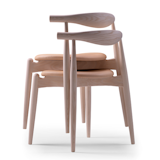Collection by Amanda Dameron
Here's how a designer makes money: One day she dreams up a chair. She spends months developing the concept, selecting materials, devising the exact curve of the arm, the dip of the back. Satisfied with the piece, she works with a manufacturer to produce it. The manufacturer refines the design, invests in tooling to build it, promotes it, and gets it to market. You, the consumer, buy it. This is an original, authentic design. We discuss why knockoff furnishings may be cheap, but for the design industry, they come with a heavy price.
In 1954 Japanese designer Sori Yanagi (1915-2011) created a stackable fiberglass piece called the "Elephant Stool" for Kotobuki, so called for its resemblance to an elephant's foot. Surviving authentic versions should have two aluminum labels glued to the underside—one featuring the manufacturer's logo and the other marked "Made in Japan".
The Round Chair, 1949, by Hans J. Wegner (1914-2007) was sometimes just referred to by the designer as "the round one" and catapulted him to the global design stage. Wegner was plucked from design school after only two years to work for architects Erik Møller and Arne Jacobsen, and this piece reflects his interest in Chinese furniture, as well as his interpretation of traditional Danish rounded-back chairs.
Before her education at the School of Arts, Crafts and Design, Grete Jalk (1920-2006) trained as a cabinetmaker and experimented widely with industrial furniture and products. She was a pupil of Kaare Klint. One of her major preoccupations was the exploration of laminated wood—this curiosity led to her 1963 Bow Chair, which is bent in only one plane, but the two connected parts make the chair appear to be stressed to the point of breaking.














